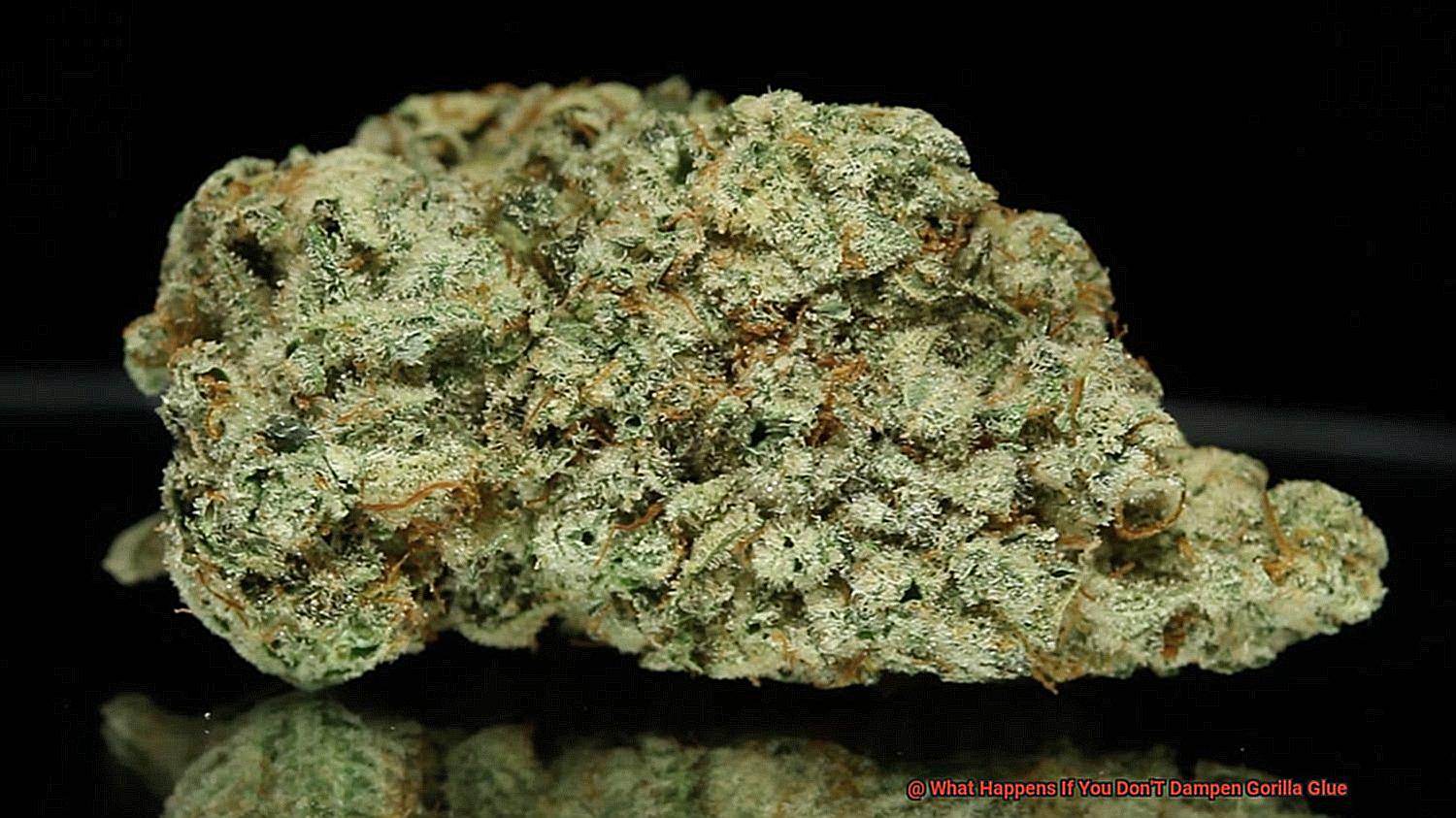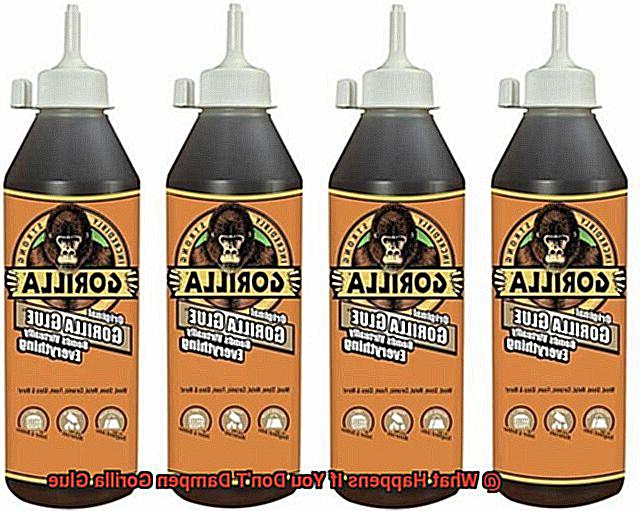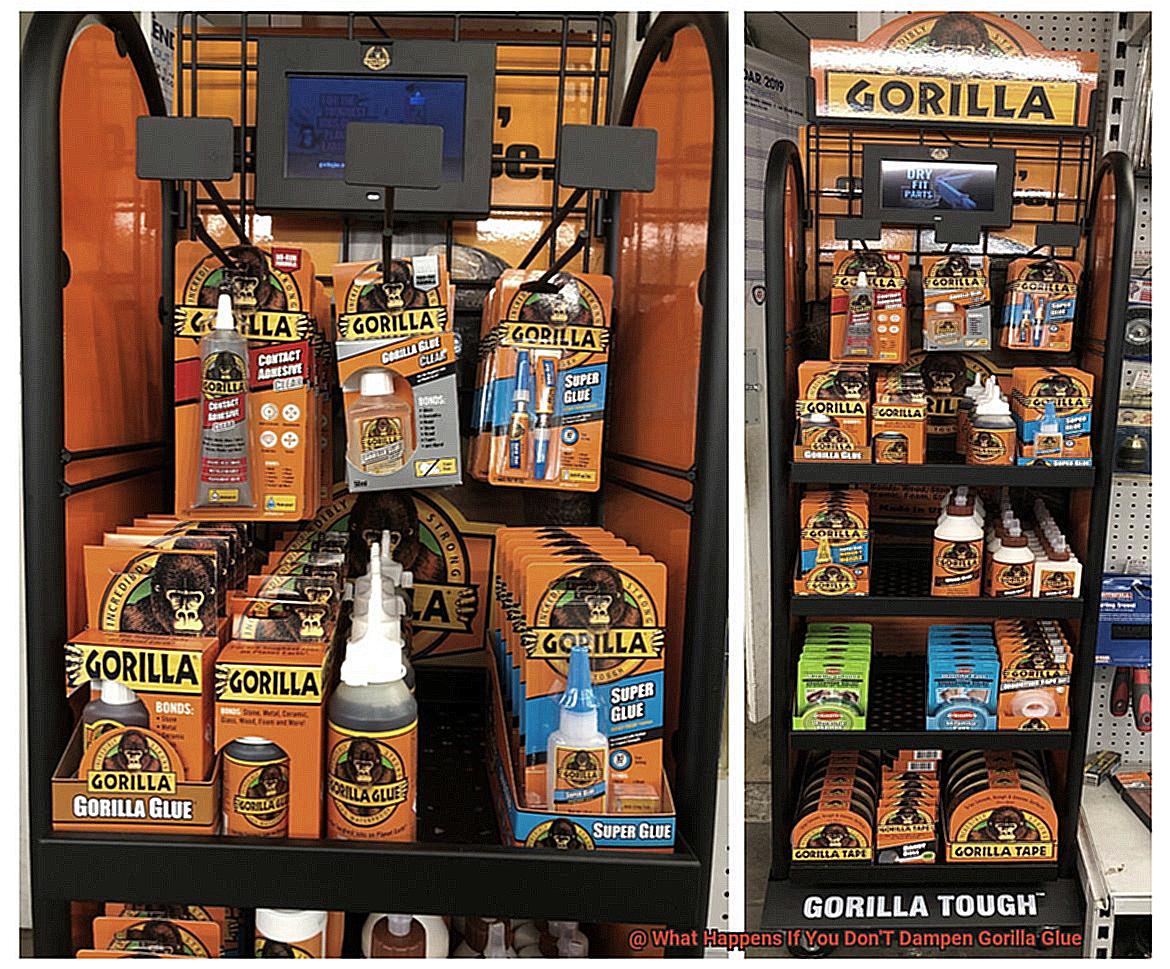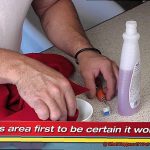Buckle up because today we’re diving headfirst into the world of adhesive wonders. Our mission? To answer a burning question that often slips under the radar when working with the incredible Gorilla Glue: What happens if you neglect to dampen it before use?
Now, don’t get us wrong – we adore Gorilla Glue for its mind-blowing bonding strength, unmatched versatility, and ability to stick just about anything together. But here’s the thing that folks tend to overlook: this mighty glue needs a little moisture lovin’ to unleash its full adhesive potential. Neglecting this crucial step can lead to some unforeseen, and let’s be real, super sticky consequences. So, if you’re ready for an adventure through the land of glue mishaps, let’s find out what could go haywire and why dampening Gorilla Glue is absolutely essential.
Join us as we unravel the scientific secrets behind this adhesive marvel, uncover potential sticky messes it might cause, and learn why a sprinkle of water can make all the difference in achieving a successful bond. Trust us, you won’t want to miss this wild ride.
What is Gorilla Glue?
Contents
Are you tired of dealing with weak adhesives that fail to hold up your DIY projects? Look no further than Gorilla Glue, the adhesive powerhouse that has revolutionized the world of bonding. With its incredible strength, versatility, and durability, Gorilla Glue is a game-changer for craftsmen, DIY enthusiasts, and professionals alike.

A Bond That Defies Limits:
Gorilla Glue’s polyurethane-based formula allows it to bond to a wide range of materials. From wood and metal to stone, ceramic, fabric, and foam, this adhesive has got you covered. No matter the project at hand, Gorilla Glue provides a reliable and long-lasting bond that will withstand the test of time.
The Many Forms of Gorilla Glue:
Gorilla Glue comes in various forms to cater to different needs and preferences. Whether you prefer the ease of application with the liquid adhesive, the versatility of the gel formula for vertical surfaces, or the quick fixes provided by super glue, Gorilla Glue has a solution for every situation.
The Science Behind the Strength:
Gorilla Glue’s secret lies in its unique curing process. Upon contact with moisture, the glue undergoes a chemical reaction, expanding and hardening to create an unbreakable bond. It’s like magic in a bottle. However, it’s important to ensure that moisture is present during the bonding process for optimal results.
A Foam-tastic Advantage:
One of Gorilla Glue’s standout features is its foaming property. As it cures, the glue expands, filling in gaps and creating a tight seal. Need to fix broken furniture or fill in gaps in your DIY project? Gorilla Glue is here to save the day with its foam-tastic advantage.
Water Resistance at Its Finest:
Once cured, Gorilla Glue offers exceptional water resistance, allowing it to withstand exposure to water without compromising its bond. Rain or shine, your projects will remain intact. However, keep in mind that prolonged immersion or extreme conditions may weaken the bond over time.
Why Should You Dampen Surfaces Before Applying Gorilla Glue?
Imagine embarking on a DIY project, ready to create an unbreakable bond with the mighty Gorilla Glue. But hold on. Did you know that dampening surfaces before applying Gorilla Glue is a crucial step for achieving optimal results?
In this blog post, we will delve into the reasons why dampening surfaces is so important. We will explore the benefits of increased adhesion, improved flexibility, and reduced mess. Get ready to unlock the secrets to unbreakable bonds with Gorilla Glue.
Increased Adhesion:

Gorilla Glue is renowned for its incredible strength and durability, but it needs moisture to activate and cure properly. Dampening the surfaces before applying the glue provides the necessary moisture for a strong bond.
This moisture triggers a chemical reaction in the glue, causing it to expand and foam. As a result, the glue penetrates even microscopic crevices, creating an unbreakable bond that can withstand the test of time.
Improved Flexibility:
Dampening surfaces not only enhances adhesion but also allows for improved flexibility in the cured glue. When Gorilla Glue cures on dry surfaces, it rapidly absorbs moisture from the air. This can lead to a less effective bond and reduced flexibility.
By pre-dampening the surfaces, you ensure that the glue has enough moisture to create a strong and durable bond while maintaining flexibility in your project.
Reduced Mess:
We’ve all experienced messy glue application at some point. When Gorilla Glue comes into contact with moisture, it expands and foams. While this expansion helps with penetration and bonding, excessive foaming can lead to messy and uneven application. Dampening the surfaces before applying the glue helps control the foaming action, ensuring a cleaner and more precise bond.
Best Practices for Dampening Surfaces:
- Lightly dampen the surfaces with water using a spray bottle or a damp cloth. Avoid oversaturating the surfaces, as this can affect the glue’s performance.
- Ensure that both surfaces are evenly dampened to promote an even bond and prevent uneven curing.
- Allow the water on the surfaces to be absorbed for a few minutes before applying Gorilla Glue. This ensures that the glue has enough moisture to activate and creates a stronger bond.
What Happens if You Don’t Dampen Gorilla Glue?
If you’ve ever used Gorilla Glue, you know it’s the go-to adhesive for all your bonding needs. But did you know that there’s a crucial step that some folks tend to overlook? That’s right, we’re talking about dampening those surfaces before applying the glue. Trust me, it’s not just a mere suggestion – it’s essential for achieving the strongest bond possible.
So, what happens if you don’t dampen Gorilla Glue? Let’s dive into the consequences, shall we?
- Weaker Adhesion: Skipping the dampening step can result in weaker adhesion between the glued surfaces. Without that added moisture, the glue may struggle to bond effectively, leaving you with items that easily come apart. And let’s face it – nobody wants their hard work falling apart at the seams.
- Incomplete Bonding: Gorilla Glue is famous for its expanding properties, which help fill gaps and create a tight bond. Without dampening, the glue may not expand as intended, leading to an incomplete bond. Picture this: a half-hearted attempt at bonding that leaves your project with potential weaknesses. Not ideal, right?
- Extended Curing Time: Patience is a virtue, they say. But who wants to wait forever for their glue to dry? Certainly not us. By dampening the surfaces, you activate the glue and speed up the curing process. Without this moisture kickstart, you might find yourself twiddling your thumbs for an extended period before your glued item is ready for action.
Now, don’t get me wrong – not all materials require dampening before using Gorilla Glue. Wood and fabric benefit from being dampened prior to gluing, while non-porous materials like metal or plastic don’t require it. It’s always wise to consult the manufacturer’s instructions for specific guidelines.
To sum it up, dampening Gorilla Glue is no joke. Skipping this step can lead to weaker adhesion, incomplete bonding, longer curing times, and potential issues with the durability of your bond. So, let’s raise our glue bottles high and toast to properly preparing our surfaces for optimal results.
Potential Issues When Not Dampening Gorilla Glue
Imagine pouring your heart and soul into a DIY project, only to have it crumble before your eyes due to a simple oversight. When working with Gorilla Glue, neglecting the crucial step of dampening the surfaces can lead to a cascade of potential issues. In this article, we will dive into the consequences of skipping this vital step and explore the pitfalls that await the unprepared.
Incomplete Curing:
Gorilla Glue, renowned for its formidable bonding strength, relies on moisture to activate its curing process. By failing to dampen the surfaces, you risk hasty or incomplete curing. This can result in a feeble bond that snaps under pressure or fails to adhere entirely. Don’t let your hard work crumble – ensure proper curing by moistening those surfaces.
Excessive Expansion:
One of Gorilla Glue’s standout properties is its expansive nature, allowing it to fill gaps and create a robust bond. However, without appropriate dampening, this expansion can spiral out of control. The resulting excessive expansion can cause materials to distort or deform, undermining the appearance and functionality of your project.
Uneven Spreading:
Dampening the surfaces helps Gorilla Glue spread evenly over a larger area, ensuring a seamless bond. By skipping this step, you risk uneven spreading, leaving behind weak points in the adhesive union. These gaps undermine the overall strength of the bond and compromise its effectiveness.
Maneuvering Challenges:
Dry Gorilla Glue proves obstinate to work with – it thickens and becomes unwieldy without moisture. This viscosity change makes it arduous to achieve an even coat of glue or position materials accurately before they fuse together. Additionally, drying glue is harder to clean up, leading to frustration and potential damage to your project.
Excessive Moisture Can Compromise Bonding Abilities
Picture this: you’re knee-deep in a DIY project, excitedly reaching for your trusty Gorilla Glue, ready to create something marvelous. But wait. Did you know that excessive moisture can throw a wrench in your bonding plans?
Today, we delve into the captivating world of glue and explore how excessive moisture can compromise the bonding abilities of Gorilla Glue. So grab your favorite drink and buckle up for an enlightening journey.
The Significance of Dampening:
You might be wondering, why on earth would I want to dampen my surfaces before applying Gorilla Glue? Well, my friend, this step is a game-changer. Gorilla Glue is activated by moisture, meaning without enough of it, the glue won’t cure properly, resulting in a feeble bond. So, think of dampening as the secret ingredient that brings your project to life.
Finding the Perfect Balance:
Before you start dousing everything in sight, hold your horses. Achieving the right balance is key. Too little moisture means your bond will be as strong as wet tissue paper. On the other hand, too much moisture will leave you drowning in a foamy mess that’s harder to clean up than post-craft-party glitter.
The Consequences of Excessive Moisture:
Now, let’s talk about what happens when you neglect the delicate art of dampening. Brace yourself for disappointment. Excessive moisture dilutes the glue and alters its viscosity, making it more challenging to work with and less effective. It also causes the glue to expand, exerting pressure on the surfaces being bonded. This can lead to uneven bonding or even damage to your precious materials – a nightmare for any DIY enthusiast.
Tips for Achieving Bonding Success:
To ensure optimal bonding results, keep these tips in mind:
- Carefully read and follow the manufacturer’s instructions.
- Moisturize one surface with water or a damp cloth before applying Gorilla Glue.
- Find the sweet spot of moisture – not too little, not too much.
- Spread the glue evenly and position materials accurately before they fuse together.
- Allow sufficient time for the glue to cure, following the recommended drying time.
Tips for Proper Use of Gorilla Glue
If you’re seeking tips on how to use Gorilla Glue properly, you’ve come to the right place. Known for its exceptional strength and versatility, Gorilla Glue can bond almost anything together. However, to ensure the strongest bond possible and avoid any mishaps, it is crucial to follow the proper usage instructions. In this article, we will explore valuable tips that will help you achieve optimal results with Gorilla Glue.
Surface Preparation: Clean and Dry is the Way to Go.
Before applying Gorilla Glue, take a moment to prepare the surfaces you want to bond. Ensuring they are clean, dry, and free from any dust, dirt, or grease is essential. Why? Because a clean surface provides a solid foundation for a strong bond. So grab a cloth and wipe away any grime before embarking on your gluing adventure.
Dampen the Surfaces: Activate the Power.
Unlike other adhesives, Gorilla Glue thrives on moisture. Lightly dampen both surfaces with water before applying the glue. You can use a damp cloth or mist some water onto the surfaces. This simple step activates the curing process and helps Gorilla Glue bond like a superhero.
Thin is In: Less is More with Gorilla Glue.
When it comes to applying Gorilla Glue, remember that less is more. The glue expands as it cures, so apply just a thin layer on one of the surfaces. Trust us; a little goes a long way. Applying too much glue can lead to excessive foaming and messy results.
Clamp or Secure: Hold It Together.
To maximize bonding strength, press the surfaces firmly together after applying Gorilla Glue. If possible, use clamps to hold them in place. This ensures proper contact and a strong bond. If clamping isn’t an option, heavy objects or tape can do the trick. Just make sure you secure the bond until the glue fully cures.
Time is Key: Patience Pays Off.
Gorilla Glue needs time to work its magic, so be patient. Follow the manufacturer’s instructions for curing time. Usually, it takes 1-2 hours for the initial set and 24 hours for full cure. Avoid putting stress on the bond during this period to allow the glue to work its wonders.
Conclusion
In conclusion, dampening Gorilla Glue before use is an absolute must if you want to achieve the best bonding results. This adhesive relies on moisture to activate and cure properly, so neglecting this crucial step can set off a chain reaction of potential issues.
Without dampening the surfaces, the bond created by Gorilla Glue may be feeble, incomplete, and take an eternity to cure. The glue will struggle to adhere effectively without that added touch of moisture, resulting in items that easily come apart. And let’s not forget that without dampening, Gorilla Glue won’t expand as intended, leaving your project vulnerable with weak spots.
But wait, there’s more. Excessive moisture can wreak havoc on Gorilla Glue’s bonding abilities. It dilutes the glue, messes with its viscosity, and turns it into a tricky substance to work with. Too much moisture can cause the glue to expand excessively, leading to uneven bonding or even damaging your precious materials.
To ensure you’re using Gorilla Glue like a pro, follow these tips: start by meticulously cleaning and drying the surfaces; give them a light spritz of water before applying the glue; apply a thin layer of adhesive on one surface; firmly press those surfaces together and secure them with clamps or weighty objects; then sit back and exercise some patience while allowing sufficient curing time according to the manufacturer’s instructions.
So, remember folks, when dealing with Gorilla Glue, always take that extra moment to dampen those surfaces before slathering on the adhesive.






